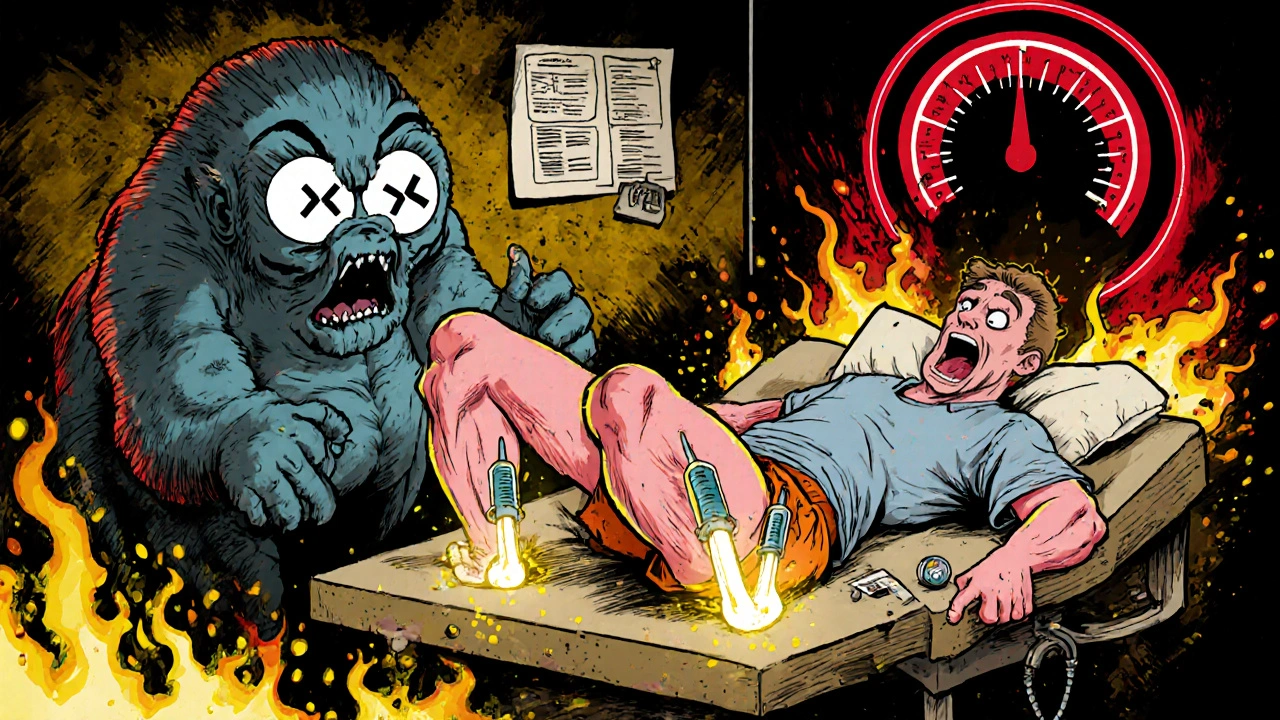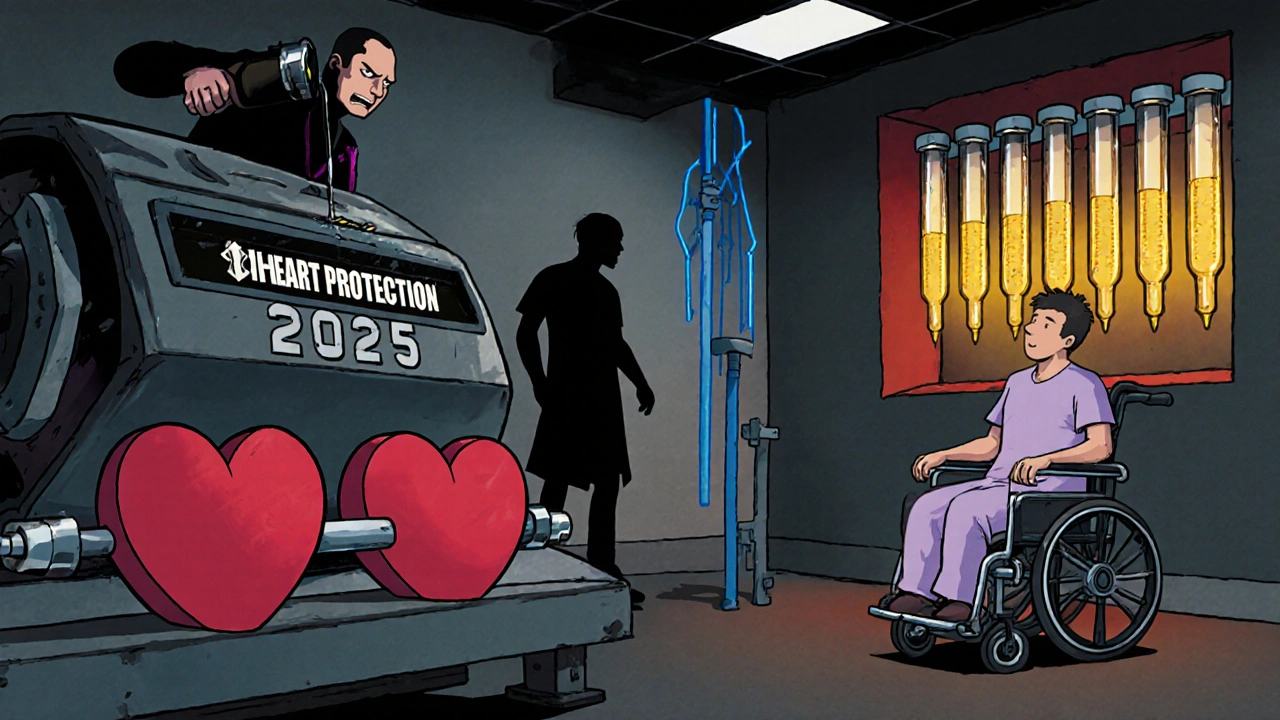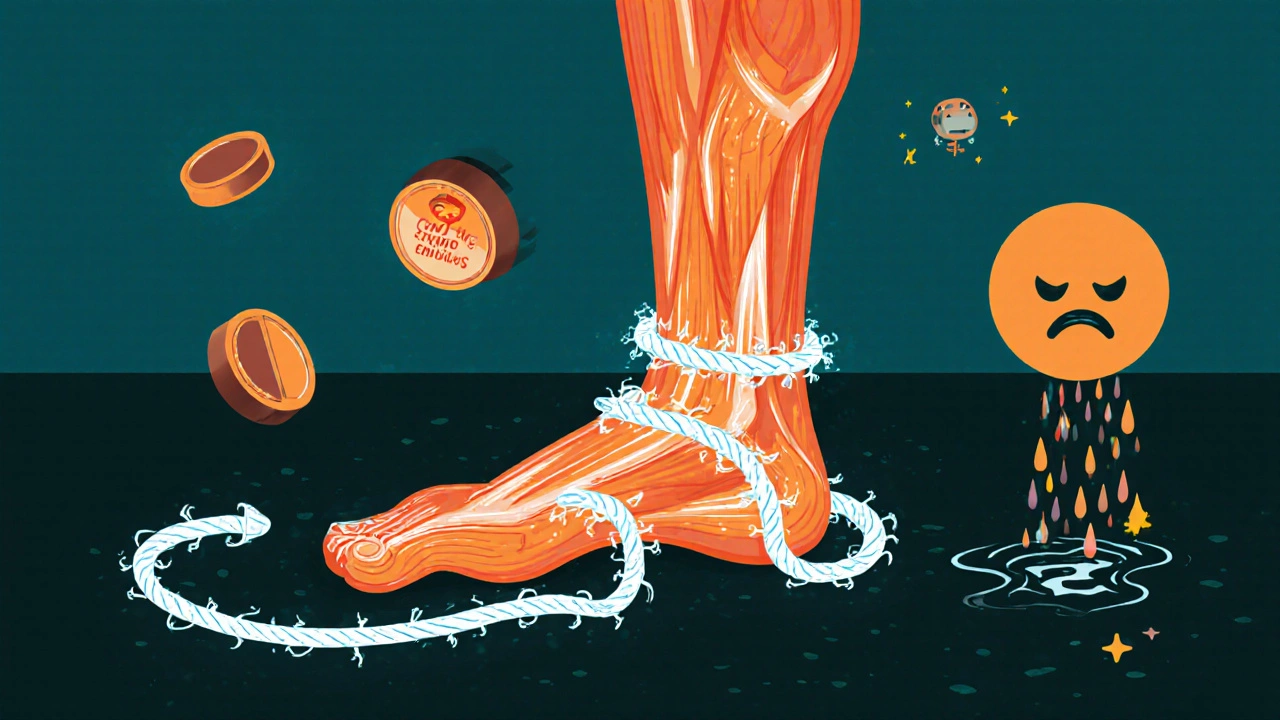Statin Muscle Pain Assessment Tool
Symptom Assessment
Answer these questions to determine if your muscle symptoms might be related to statin medication.
Your Assessment Results
Many people take statins to lower their cholesterol and protect their heart. But for some, the medication brings a frustrating and sometimes disabling side effect: muscle pain. It’s not just soreness after a workout. This is deep, persistent discomfort that doesn’t go away with rest. For some, it’s weakness that makes climbing stairs or lifting groceries feel impossible. And for a small number, it’s something far more serious.
What’s Really Going On in Your Muscles?
Statin-induced muscle pain isn’t one thing-it’s a spectrum. At the mildest end is myalgia: muscle aches or cramps without any measurable damage. Your creatine kinase (CK) levels, a marker of muscle breakdown, stay normal. This affects up to 30% of people on statins. It’s common, often dismissed as aging or inactivity, and usually fades when the statin is stopped. But then there’s myositis. This is inflammation. Your CK levels rise-sometimes 10 to 40 times above normal. Muscles swell, feel tender, and lose strength. It’s not just discomfort; it’s tissue damage. And then there’s the rare but dangerous form: rhabdomyolysis. CK levels spike above 40 times normal. Muscle fibers break down so badly that they flood your bloodstream with myoglobin, which can crash your kidneys. This happens in about 1 in 10,000 people on statins, but it’s life-threatening. And beneath all of these lies a hidden enemy: immune-mediated necrotizing myopathy (IMNM), also called statin-associated autoimmune myopathy (SAAM). This isn’t just a reaction to the drug-it’s your immune system turning on your own muscles. It happens in roughly 2 to 3 out of every 100,000 statin users. But when it does, it’s brutal.Why Do Statins Hurt Your Muscles?
Statins work by blocking HMG-CoA reductase, an enzyme your liver uses to make cholesterol. But that same enzyme is also part of a bigger system called the mevalonate pathway. This pathway doesn’t just make cholesterol-it makes other critical compounds your muscles need. One of them is coenzyme Q10 (CoQ10). It’s essential for energy production inside muscle cells. Studies show that taking 40 mg of simvastatin daily can drop CoQ10 levels by 40%. Without enough CoQ10, your muscles run out of fuel. You feel tired. Weak. Achy. Statins also interfere with prenylation-a process that helps proteins stick to cell membranes. When this breaks down, calcium leaks into muscle cells at abnormal levels. Too much calcium triggers enzymes that chew up muscle proteins. Think of it like your body’s own demolition crew going into overdrive. And then there’s the immune angle. In SAAM, your body starts producing antibodies against HMGCR-the very enzyme statins block. These antibodies attack your muscle tissue. Muscle biopsies show dead muscle fibers with almost no inflammation, which is why it’s called “necrotizing.” It’s not an infection. It’s an autoimmune war. Genetics play a role too. People with a specific gene variant, SLCO1B1 rs4149056, are more likely to develop muscle pain. African Americans have nearly double the risk compared to Caucasians, likely because of this and other inherited differences in how statins are processed.How Do You Know It’s Not Just Aging or Overtraining?
The big clue? Timing. If you started feeling muscle pain within weeks or months of beginning a statin-and you didn’t have it before-there’s a strong chance it’s related. Myalgia usually feels like dull, generalized aches. You might notice it more after walking or standing for long periods. Myositis feels deeper. Muscles feel tight, swollen, or tender to the touch. You might struggle to get up from a chair or raise your arms. SAAM is different. It doesn’t improve after stopping the statin. In fact, it often gets worse. People report progressive weakness in their hips and shoulders over months. Some can’t lift their arms to brush their hair. Others can’t climb stairs without holding the railing. And here’s the kicker: 50% of SAAM patients still have symptoms six to twelve months after quitting statins. Doctors look for three things:- CK levels above 10 times the upper limit of normal (normal range: 30-200 IU/L)
- Progressive proximal weakness (hips, shoulders, thighs)
- Positive anti-HMGCR antibodies in the blood

What Do You Do If You Think Statins Are Causing Your Pain?
Don’t panic. Don’t quit cold turkey. But don’t ignore it either. Step one: Talk to your doctor. Get your CK levels checked. Rule out other causes like thyroid problems, vitamin D deficiency, or other medications that interact with statins-like amiodarone or certain antibiotics. These can boost statin levels by 300-500% and make muscle damage much more likely. If your CK is normal and pain is mild, you might try switching statins. Some people tolerate rosuvastatin or pravastatin better than simvastatin or atorvastatin. A 2021 study showed 73% of people who couldn’t take simvastatin did fine on rosuvastatin. Another option: reduce the dose or take it every other day. The IMPROVE-IT trial found that 40% of people with muscle pain tolerated lower or intermittent dosing without losing heart protection. If CK is high and symptoms persist beyond three months, get tested for anti-HMGCR antibodies. If positive, you likely have SAAM. This isn’t something you can treat with rest or supplements. You need immunosuppression.Treatment for Immune-Mediated Myopathy
SAAM requires a neurologist or rheumatologist. It won’t get better on its own. Standard treatment starts with high-dose prednisone-about 1 mg per kilogram of body weight daily. That’s often 60-80 mg a day. Then, doctors add methotrexate or mycophenolate to reduce steroid use. About 60-70% of patients go into remission within 6-12 months. For those who don’t respond, IVIG (intravenous immunoglobulin) helps. One Reddit user described 18 months of weakness before IVIG gave him back his mobility. Others need rituximab or even complement inhibitors like ravulizumab, which showed a 75% response rate in a 2022 pilot study. CoQ10 supplements? They sound logical. But the evidence is mixed. Three out of seven trials showed benefit. The rest didn’t. Don’t rely on it alone.
What Happens If You Don’t Treat It?
If you ignore SAAM, muscle damage keeps building. You could lose the ability to walk independently. You might need a wheelchair. Recovery takes longer the longer you wait. Studies show that people treated within six months of symptom onset have a 65% chance of full recovery. If treatment is delayed past a year, that drops to 28%. And here’s the cruel twist: stopping statins increases your risk of heart attack or stroke. In one 2023 study, people who quit statins due to muscle pain had a 25% higher chance of major cardiovascular events over 10 years. That’s why the goal isn’t just to stop the pain-it’s to find a way to protect your heart and your muscles.The Future: Personalized Statin Therapy
We’re moving toward smarter prescribing. Genetic testing for SLCO1B1 variants can now predict who’s at higher risk. In the next five years, doctors may use polygenic risk scores to pick the safest statin for you before you even start. New blood tests are emerging too. A 2023 study identified a panel of microRNAs-miR-206 and miR-133a-that can distinguish immune myopathy from regular statin pain with 89% accuracy. That could cut diagnosis time from months to weeks. For now, if you’re on a statin and have unexplained muscle pain, don’t brush it off. Don’t assume it’s just part of getting older. Get checked. Get tested. Your muscles-and your heart-depend on it.When to Seek Help
See your doctor if you experience:- Muscle pain or weakness that started after beginning a statin
- Pain that doesn’t improve after stopping the drug
- Dark urine (sign of myoglobin in the blood)
- Severe fatigue or trouble climbing stairs or lifting arms
- Swelling or tenderness in thighs or shoulders
